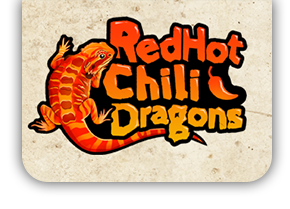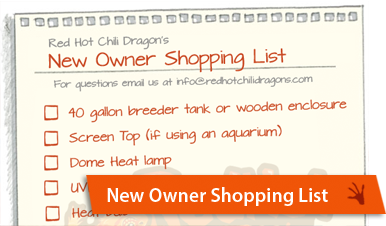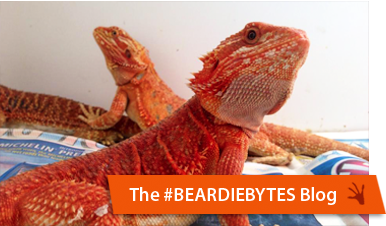New Beardie Owner Shopping List
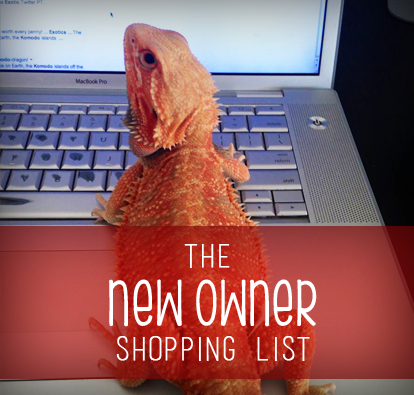
Bearded dragons are one of the hardiest lizards available in the pet industry. Coupled with the fact that they are easily handleable, grow to a manageable size, come in many different colours and are bursting with personality they make wonderful beginner pets.
Walking into a shop to buy equipment and supplies can be daunting especially when the pet store employees may not be trained in bearded dragon pet care.
Here I hope to help walk you through the do’s and don’ts when purchasing supplies for your new bearded dragon.
Together we’ll help you save money and buy the best items to help you raise a happy and healthy dragon.
The Enclosure
Let’s start with the enclosure! Essentially your dragon’s home sweet home. There are many options available as far as dragon housing is concerned.
Glass Aquariums
The most common enclosure is the glass tank. Here are the sizes that we recommend.
You’ll Need:
• 20 gallon long tank for juveniles
• Minimum of 40 gallon breeder for adults
You can purchase the adult sized tank for your baby and block off half of the tank with a piece of cardboard cut to the shape and attach it using tape. Stick the tape on the side that the beardie is not housed in. This way he can’t eat or tear at the tape.
There are many different glass tanks. The aquarium ones that open from the top, and the zoomed, or exo terras that open from the front. We prefer the ones that open from the front since it gives us better access to our dragons without having to remove eeeeverything from the top of the tank to access. Either choice won’t affect the health of your dragon.
When purchasing a tank with an open top, you may also need to purchase a screen top separately.
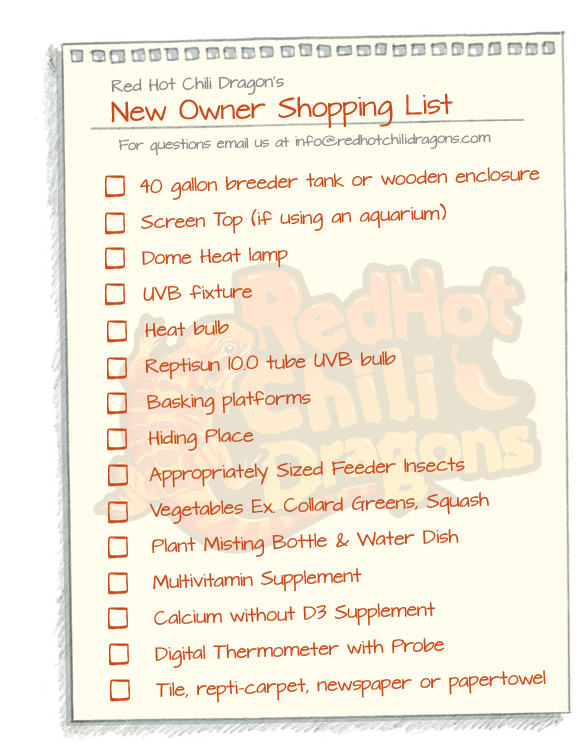
Wooden Enclosures
These are our preferred enclosures for our dragons. We build all of our own wooden enclosures out of plywood and front sliding glass doors. It helps to limit the reflections of the dragons on the glass. For some dragons the sight of their reflections in the glass tends to stress them out.
We also love these wooden enclosures because they end up being stackable and the best part? It helps to keep the heat in. We end up using lower wattage bulbs throughout the day (which saves us some money on heating bills!) and during the night once the lights are out, the enclosure takes longer to cool down.
**NOTE** Whether you end up using a screen covered tank or a wooden one, always make sure that the lights are not covered by glass or any other obstruction. The UVB cannot pass through glass.
Low tanks are recommended over high tanks as they give best access to the full spectrum light.
Supply branches as basking sites, particularly in tall tanks.
Many people construct their own housing for adult dragons.
screen top (glass or plastic won’t pass the critical UVB light)
Again, many people make their own cage cover.
basking site (wood, rock, piece of lumber) that lets your dragon get within 6 inches of the UVB light.
hiding site
e.g., piece of bark, small box
some like a paper towel as a “blankie” to sleep under
Heat & Lighting
These are the MOST important supplies to have when owning a bearded dragon. These sun loving lizards truly love their light and heat and simply thrive under the right lighting conditions.
Heating
You’ll need a heat bulb and a lamp fixture to run it. We recommend getting the dome lamps to run the bulbs. Remember to check the maximum wattage output the lamp can safely run before purchasing. We usually get the 8.5″ domes as those are rated for up to 150watts.
For the heat bulbs we recommend buying halogen flood lamps from your local hardware store. They are the exact same bulbs as you would find at a pet store but cost much less. If you prefer to purchase one from the petstore, you can too. Just make sure that they are the clear bright lamps and not the colourful red/blue bulbs. A 50watt halogen bulb is usually good for a 40 gallon tank. Always check your temps using a digital thermometer with a probe.
It is hard to tell people what wattage of bulb to buy as your houses may all be different temperatures. For example keeping a beardie in the basement may require higher wattage for heating than one kept upstairs in a warmer room.
You’ll Need:
• Dome lamp to run heat bulb
• 25-50 watt heat bulb
UVB Lighting
This light is very important! It outputs uv rays which help your dragon metabolize calcium and enable proper body function and growth. Without the light you’re dragon will often become stunted and fall ill to Metabolic Bone Disease (MBD). For further details regarding MBD prevention please refer to our Care Sheet
You’ll Need:
• Fluorescent fixture (“striplight”) to run your light. You can take a look at the ones at your hardware store which may be cheaper.
• UVB light bulb
Thermometer
You need 95-105 deg F at the basking site and 70-80 deg F at the cool end. To figure out your temperature output you’ll need to purchase a good thermometer.
You’ll Need:
• digital thermometer with probe OR
• Infrared Heat Gun (Laser Temp Gun)
DON’T: Don’t buy any stick on or plastic dial thermometers. They are useless and a waste of money. They break very easily and are usually off by 5-10 degrees. Purchase a digital thermometer with a probe. They are not too pricey and will give you accurate readings of your dragons’ temperature. You may also purchase a temp gun to get even more accurate readings.
Food and Hydration
Ah the bearded dragon’s #1 most favourite thing in the world. Food.
Purchase appropriately sized insects for your dragon to eat. You can approximate the size by looking at the space between your dragons eyes. That’s the size your dragon’s insects should be. Too large and the dragon may have trouble digesting the morsel or even become afraid of the food item and try to hide from them.
Insects!
We recommend feeding Crickets, Hornworms, Silkworms, Butterworms and Phoenix Worms (also called Repti-worms or black soldier fly larvae)
For Superworms we recommend feeding them once the dragon is 5 months old. Once old enough they make an excellent staple. For younger dragons they may be harder to digest.
DON’T: Don’t bother with mealworms. They have so much chitin (what their exoskeleton is made of) in them that they are basically just filler. They are hard for babies to digest, and once you have an adult dragon, you’ll need too many to keep an adult full. If you do prefer to feed them, please make sure your temps are all correct and proper hydration is provided to ensure the beardie is able to digest them properly. If not it could lead to impaction risks.
You can purchase a small critter keeper to help hold your bugs in. If you’re like me and end up buying 1000’s of crickets a week, you can buy a large rubbermaid sweaterbox to keep them in.
The Green Stuff!
Gross the green stuff! A.K.A the vegetables. We recommend purchasing dark leafy greens such as collard greens, dandelions, kale, bok choi and mustard greens as your salad base. I then like buying boxes of springmix to mix in with the rest. To add to it I grate some carrots and butternut squash as salad toppers. Every now and then they also get fruit treats such as assorted berries, bananas, apples and strawberries.
You’ll Need:
• Appropriately Sized Insects
• insect keeper
• Assorted vegetables, squash and fruits.
Hydration
Although these guys are from arid locations in Australia, does not mean that they get zero amounts of water. You can provide your dragon with a dish filled with water, but you’ll find that they may not be interested in the water at all. They much prefer lapping up morning dew and rain water than drinking for a large, still body of water.
It’s good to purchase a plant mister and/or eyedropper to “water” your dragons. Lightly mist or drop the water on the tip of your dragons nose. It’s best to do this an hour after lights turn on in the morning. Lightly spray where the dragon is sitting. Do not mist the entire enclosure. This way the enclosure has time to dry before bedtime. You should also mist your dragon’s salad to provide more hydration options.
You’ll Need:
• plant mister
Calcium and Multivitamin Supplements
Purchase a few supplements to help keep your dragon healthy and happy.
You’ll Need:
• Calcium without D3 powder
• Multivitamin powder
We use the repCal brand ourselves. For juveniles we do a strict regimen of dusting their food source once daily five days a week. Crickets are dusted three times weekly for sub-adult and adult dragons. Our greens and bugs are dusted with a multivitamin twice weekly.
Substrate
Substrate for a bearded dragon is one of the most debated topics of ownership. We go by what we’ve learned from talking with other reputable breeders as well as from personal experience in the last 10 years of keeping dragons.
For our babies and juvenile dragons we have them on papertowel, newspaper or ceramic tile. This way we can keep the babies’ enclosures clean, and allow them to catch their food much easier. It also allows us to monitor their poop.
For our adults we use slate tiles, newspaper or a dirt mixture. The mixture is made of chemical free top soil, children play sand and coconut coir.
Why don’t we use sand? We find it’s dusty, smells really bad after a while, and harbours bacteria. Without proper hydration and heat, it can also lead to impaction of the dragon when ingested by accident.
You’ll Need:
• Ceramic Tiles, paper towel or newspaper
DON’T: Don’t bother buying calcium sand, or crushed walnut shells. They’re dusty, can lead to your dragon impacting,and the coloured ones can dye your dragon.
Accessories
The fun part! Decorating your dragon’s crib! It’s great to provide your dragon fun ways to exercise, climb and run around on.
You’ll Need:
• Basking platform
• Hiding place
Your dragon will need a platform that they can perch on top of and bask. This can be a slab or bark, logs, rocks, bricks or a premade decoration from the pet store.
Your dragon will also need a hiding place located in the cool side. This can be a half log, cardboard box, or a premade decoration from the store.
What You Don’t Need
Here’s a small list of things you don’t ever need to buy your dragons.
DON’T USE:
• Heat Rocks
• Calcium Sand
• Red/blue coloured heat bulbs
• stick on or dial thermometers
Heat rocks are a big no no. I don’t know why the stores are still selling these pieces of junk. The heat rocks tend to get too hot and burn the underside of your dragons.
Calcium sand has been linked to causing impaction in beardies. We do not recommend purchasing these. If you want to use a loose substrate we recommend doing a mixture of playsand, soil, clay and coconut mulch.
Red lights or coloured lights affect the way they see. Colored “night lights” were brought out as it was thought bearded dragons couldnt see infrared lighting and certain colors, but has since been proven they can. In fact they have the ability to see colours we cant (down into the UV spectrum). So when we give them poor lighting like red lights, it not only affects how they see (and that would be all day, every day) but also can affect the systems in their body that are reliant on UVA wavelengths.
Stick on or Dial thermometers as stated above are never accurate and are usually 5-10 degrees off. They are not reliable at all and you are better off going with a digital one.
The Shopping List:
- 40 gallon breeder tank or wooden enclosure (20 gallon long for babies)
- Screen Top (if using an aquarium)
- Dome Heat lamp
- UVB fixture
- Heat bulb
- Reptisun 10.0 tube bulb
- Basking platforms
- Hiding Place
- Appropriately Sized Insects Ex. Crickets, Silkworms, Hornworms, Phoenix Worms
- Vegetables Ex. Collard Greens, Squash
- Plant misting bottle and water dish
- Multivitamin Supplement
- Calcium without D3 Supplement
- Digital Thermometer with Probe (or Heat gun)
- Tile, repti-carpet, newspaper or papertowel
